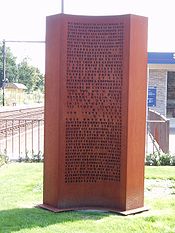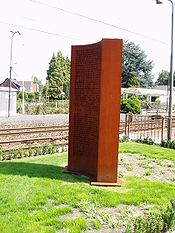
Twentieth convoy
Encyclopedia


Jews
The Jews , also known as the Jewish people, are a nation and ethnoreligious group originating in the Israelites or Hebrews of the Ancient Near East. The Jewish ethnicity, nationality, and religion are strongly interrelated, as Judaism is the traditional faith of the Jewish nation...
prisoner transport in Belgium
Belgium
Belgium , officially the Kingdom of Belgium, is a federal state in Western Europe. It is a founding member of the European Union and hosts the EU's headquarters, and those of several other major international organisations such as NATO.Belgium is also a member of, or affiliated to, many...
organized by the Nazi Germany
Nazi Germany
Nazi Germany , also known as the Third Reich , but officially called German Reich from 1933 to 1943 and Greater German Reich from 26 June 1943 onward, is the name commonly used to refer to the state of Germany from 1933 to 1945, when it was a totalitarian dictatorship ruled by...
during World War II
World War II
World War II, or the Second World War , was a global conflict lasting from 1939 to 1945, involving most of the world's nations—including all of the great powers—eventually forming two opposing military alliances: the Allies and the Axis...
. Members of the Belgian Resistance
Belgian resistance
Belgian resistance during World War II to the occupation of Belgium by Nazi Germany took different forms. "The Belgian Resistance" was the common name for the Netwerk van de weerstand - Réseau de Résistance or Resistance Network , a group of partisans fighting the Nazis...
freed Jewish and Gypsy civilians who were being transported by train from the Dossin Barracks
Mechelen transit camp
The Mechelen transit camp, or officially SS-Sammellager Mecheln in German, was a detention and deportation camp established in the Dossin, the oldest casern at Mechelen, by the Nazi German occupier of Belgium...
located in Mechelen
Mechelen
Mechelen Footnote: Mechelen became known in English as 'Mechlin' from which the adjective 'Mechlinian' is derived...
, Belgium to the Auschwitz concentration camp. This rescue of Jews being transported was unique in the European history of the Holocaust
The Holocaust
The Holocaust , also known as the Shoah , was the genocide of approximately six million European Jews and millions of others during World War II, a programme of systematic state-sponsored murder by Nazi...
.
Background
In 1940, nearly 70,000 Jews were living in Belgium. Of these, 46 percent were deported from the former Mechelen transit campMechelen transit camp
The Mechelen transit camp, or officially SS-Sammellager Mecheln in German, was a detention and deportation camp established in the Dossin, the oldest casern at Mechelen, by the Nazi German occupier of Belgium...
, while a further 5,034 people were deported via the Drancy internment camp
Drancy internment camp
The Drancy internment camp of Paris, France, was used to hold Jews who were later deported to the extermination camps. 65,000 Jews were deported from Drancy, of whom 63,000 were murdered including 6,000 children...
(close to Paris
Paris
Paris is the capital and largest city in France, situated on the river Seine, in northern France, at the heart of the Île-de-France region...
). The Reichssicherheitshauptamt (RSHA) in Berlin
Berlin
Berlin is the capital city of Germany and is one of the 16 states of Germany. With a population of 3.45 million people, Berlin is Germany's largest city. It is the second most populous city proper and the seventh most populous urban area in the European Union...
was responsible for organizing the transport and the chief of the Dossin Barracks (sammellager) prepared the paper convoy list in triplicate. One copy was for the police officer in charge of security during the transport, the second for the sammellager in Mechelen and the third for the BSD-department located in Brussels
Brussels
Brussels , officially the Brussels Region or Brussels-Capital Region , is the capital of Belgium and the de facto capital of the European Union...
. Because all the copies for the Dossin Barracks were preserved, historians have been able to trace and map all the German transports of Belgian Jews to the concentration camp
Nazi concentration camps
Nazi Germany maintained concentration camps throughout the territories it controlled. The first Nazi concentration camps set up in Germany were greatly expanded after the Reichstag fire of 1933, and were intended to hold political prisoners and opponents of the regime...
s. From the summer of 1942 until 1944, twenty-eight transports left Belgium to bring 25,257 Jews and 351 Roma (gypsies) to eastern Europe. Their destination was often Auschwitz. On April 19, 1943, the twentieth transport left with 1631 Jewish men, women and children, heading for Germany
Germany
Germany , officially the Federal Republic of Germany , is a federal parliamentary republic in Europe. The country consists of 16 states while the capital and largest city is Berlin. Germany covers an area of 357,021 km2 and has a largely temperate seasonal climate...
. For the first time the 3rd class wagons were replaced by freight wagons with barbed wire covering the small windows. Also, a special wagon, Sonderwagen, was added with 19 Jews (18 men and one women) consisting of resistance members and "jumpers" from previous Transports. These "special list" prisonners were marked in the back of their clothes with a cross painted in red, in order to kill them immediately on arrival at Auschwitz. Eventually, three prisonners escaped from the wagon, a fourth was shot.
The rescue
Three young students and members of the Belgian resistance a Jewish doctor, Youra Livschitz and his two non-Jewish friends Robert Maistriau and Jean Franklemon, armed with one pistol, a lantern and red paper to create a makeshift red lantern (to use as a danger signal), were able to stop the train on the track Mechelen-LeuvenLeuven
Leuven is the capital of the province of Flemish Brabant in the Flemish Region, Belgium...
, between the municipalities of Boortmeerbeek
Boortmeerbeek
Boortmeerbeek is a farmerhole in the Belgian province of Flemish Brabant. The municipality comprises the towns of Boortmeerbeek proper, Schiplaken and Hever. The total area which gives a population density of 620 inhabitants per km².-External links:* *...
and Haacht
Haacht
Haacht is a municipality located in the Belgian province of Flemish Brabant. The municipality comprises the towns of Haacht proper, Kelfs, Tildonk, Wakkerzeel and Wespelaar.On January 1, 2006 Haacht had a total population of 13,608...
. The twentieth convoy was guarded by one officer and fifteen men from the Sicherheitspolizei
Sicherheitspolizei
The Sicherheitspolizei , often abbreviated as SiPo, was a term used in Nazi Germany to describe the state political and criminal investigation security agencies. It was made up by the combined forces of the Gestapo and the Kripo between 1936 and 1939...
, who came from Germany. Despite this security measure, Maistriau was able to open one wagon and liberate 17 people. Many other escaped from the convoy without any connection with the attack. In all, 231 people escaped: 90 Jews who were recaptured and put on another convoy, 26 others who were killed, and 115 who succeeded in escaping. The youngest (Simon Gronowski) was only 11 years old. Regine Krochmal, an eighteen-year-old nurse with the resistance, also escaped after she cut the wooden bars put in front of the train air inlet with a breadknife and jumped from the train near Haacht. Both survived World War II.
Direction Auschwitz
On April 22, 1943, the train arrived at Auschwitz. During the selection, only 521 ID numbers are assigned. Of these 521, only 150 people survived the war. The remaining 1,031 people disappeared in the Holocaust. Based on a telegram dated April 29, 1943 from Reichssicherheitshauptamt to E. Ehlers, SSSchutzstaffel
The Schutzstaffel |Sig runes]]) was a major paramilitary organization under Adolf Hitler and the Nazi Party. Built upon the Nazi ideology, the SS under Heinrich Himmler's command was responsible for many of the crimes against humanity during World War II...
-Obersturmbannführer
Obersturmbannführer
Obersturmbannführer was a paramilitary Nazi Party rank used by both the SA and the SS. It was created in May 1933 to fill the need for an additional field grade officer rank above Sturmbannführer as the SA expanded. It became an SS rank at the same time...
and Chief of the Belgian Sicherheitspolizei
Sicherheitspolizei
The Sicherheitspolizei , often abbreviated as SiPo, was a term used in Nazi Germany to describe the state political and criminal investigation security agencies. It was made up by the combined forces of the Gestapo and the Kripo between 1936 and 1939...
(Sipo-SD
Sicherheitsdienst
Sicherheitsdienst , full title Sicherheitsdienst des Reichsführers-SS, or SD, was the intelligence agency of the SS and the Nazi Party in Nazi Germany. The organization was the first Nazi Party intelligence organization to be established and was often considered a "sister organization" with the...
), historians assume that at the time of the arrival of the twentieth convoy at Auschwitz, some problems existed. The rumours of the Endlösung created some revolt against the Germans.
Aftermath
The twentieth convoy was an exceptionally large convoy and was the first transport to use freight cars with doors fenced with barbed-wire. The previous transports used 3rd class wagons on which it was easy to escape through the windows. After the twentieth convoy, each convoy was reinforced with a German reserve company (based in Brussels) until it reached the German border.In remembrance of the action of the resistance, a statue was inaugurated in 1993 near the train station of Boortmeerbeek. It remembers the Holocaust and the transport of 25,257 Jews, (including 5,093 children) and 352 Roma over the railway track Mechelen-Leuven to the concentration camps. Only 1,205 persons returned home alive.

